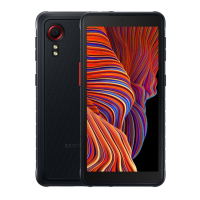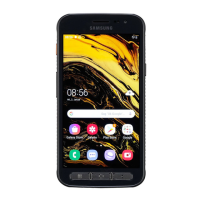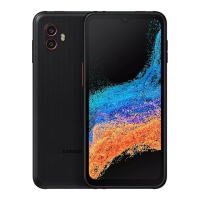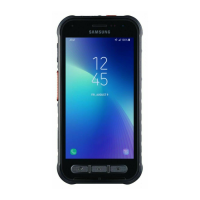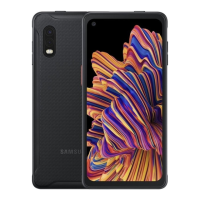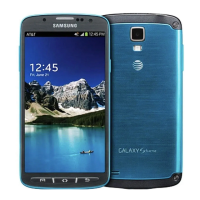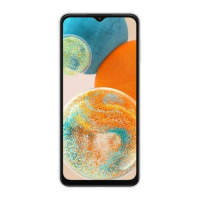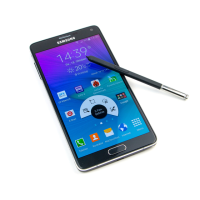Do you have a question about the Samsung Galaxy XCover 4 and is the answer not in the manual?
Important safety and usage guidelines before operating the device.
Explanation of icons used for warnings, cautions, and notices.
Identifies causes of device overheating and provides solutions.
Guidelines for maintaining the device's water and dust resistance.
Lists product box items and illustrates device components.
Details the function of each physical key on the device.
Step-by-step instructions for inserting and removing the device's battery.
Procedures and precautions for charging the device's battery.
Tips for reducing battery consumption and activating power saving modes.
Steps to insert and remove a SIM or USIM card into the device.
Guide to inserting, removing, and formatting microSD cards.
How to power the device, restart it, and interact with the touchscreen.
Explains basic and advanced touch gestures for device interaction.
Introduction to the Home screen and how to customize its layout.
Instructions for moving, removing items, and creating folders on the Home screen.
How to search for content and understand status bar indicator icons.
How to set up and use the device's lock screen for security.
How to view notifications and use quick setting buttons for features.
Details the device's keyboard layout and how to enter text.
How to manage text, capture screens, and open/close applications.
Overview of Secure Folder and steps for creating and managing it.
Overview and usage of the Multi window feature for split-screen multitasking.
Overview of Samsung account and steps for management and data transfer.
Methods for transferring data wirelessly, via computer, and Samsung Cloud.
How to use Samsung Cloud and connect the device to a PC for data transfer.
Methods for updating the device's software over the air or via Smart Switch.
How to back up and restore data using Samsung or Google accounts.
Steps for resetting the device to factory defaults.
How to share various types of content using different methods.
How to activate and use Emergency mode to conserve battery.
Downloading apps from Galaxy Apps and Play Store, and managing installed apps.
How to manage app permissions and enable/disable apps.
Steps for making voice and video calls on the device.
Using speed dial, international calls, blocking numbers, and call options.
How to create and manage contacts on the device.
Methods for adding, importing, and syncing contacts with accounts.
How to search for contacts and share contact information.
Overview of sending, viewing, and managing messages and notifications.
Guide to browsing the internet, secret mode, and basic navigation.
Setting up email accounts for sending and receiving emails.
Overview of camera, gestures, taking photos, and recording videos.
Camera settings for resolution, flash, and locking focus/exposure.
Details on using various camera modes like Auto, Pro, Panorama, and Selfie.
Overview of quick settings and camera options for rear and front cameras.
Overview of Gallery and how to view, edit, and manage images.
Managing videos, albums, stories, and syncing gallery content with Samsung Cloud.
Overview of creating and managing notes with text, drawing, and media.
Overview of Calendar and how to create and save events and tasks.
Steps to start, use, and track health and fitness goals with S Health.
Instructions for recording, pausing, bookmarking, and saving voice memos.
How to set alarms, use world clock, stopwatch, and timer.
How to perform calculations and listen to FM radio.
Introduction to Google apps like Chrome, Gmail, Maps, YouTube, etc.
Steps to connect the device to a Wi-Fi network.
Using Wi-Fi Direct for direct device connections and data sharing.
Steps for pairing Bluetooth devices and transferring data.
How to unpair Bluetooth devices and monitor data usage.
Setting data limits to automatically disable mobile data when the limit is reached.
How to activate and use flight mode to disable wireless functions.
How to use NFC for reading tags and making payments.
Using NFC for sending data between devices via Android Beam.
How to set up and use the mobile hotspot and tethering features.
Configuring mobile network settings like data roaming and network mode.
Changing settings for location information permissions and accuracy.
How to add printer plug-ins and print content from the device.
Using Download Booster for faster file downloads.
Customizing sound modes, ringtones, vibration, and notification sounds.
How to customize notification settings for apps.
Adjusting display brightness and other screen options.
Using the blue light filter and switching to easy mode.
How to switch between modes and manage screen shortcuts.
Features like one-handed mode, smart alert, and SOS messages.
Overview of battery, storage, memory, and security status checks.
Using quick optimization and managing battery and memory.
Managing device memory and checking security status.
Configuring screen lock types, notifications, and Find My Mobile.
Overview of syncing, backing up, and managing accounts.
Managing cloud storage, backup/restore, and adding/removing accounts.
Detailed settings for backing up and restoring data with Samsung and Google.
Customizing settings to improve device accessibility for various users.
Customizing system settings like language, date, and reset options.
Methods for updating the device's software over the air or via Smart Switch.
Accessing the user manual and viewing device information.
Explanation of codes like PIN, PUK, and PIN2 required by the device.
Troubleshooting network errors, service messages, and device power problems.
Troubleshooting touchscreen problems and device freezes or fatal errors.
Troubleshooting call connection, audio quality, and battery issues.
Troubleshooting photo quality and Bluetooth connection problems.
Troubleshooting computer connection and storage space issues.
| Panel type | TFT |
|---|---|
| Screen shape | Flat |
| Pixel density | 294 ppi |
| Second display | No |
| Display diagonal | 4.99 \ |
| Touch technology | Multi-touch |
| Touchscreen type | Capacitive |
| Display resolution | 1280 x 720 pixels |
| Display number of colors | 16 million colors |
| Flash type | LED |
| Sensor type | CMOS |
| Rear camera type | Single camera |
| Maximum frame rate | 30 fps |
| Video recording modes | 1080p |
| Rear camera aperture number | 1.9 |
| Resolution at capture speed | 1920x1080@30fps |
| Front camera aperture number | 2.2 |
| Rear camera resolution (numeric) | 13 MP |
| Front camera resolution (numeric) | 5 MP |
| Processor cores | 4 |
| Processor family | - |
| Processor frequency | 1.4 GHz |
| RAM type | LPDDR3 |
| RAM capacity | 2 GB |
| Compatible memory cards | MicroSD (TransFlash) |
| Maximum memory card size | 256 GB |
| Internal storage capacity | 16 GB |
| 4G standard | LTE-TDD |
| 2G standards | GSM |
| 3G standards | UMTS, WCDMA |
| SIM card type | MicroSIM |
| Wi-Fi standards | 802.11a, 802.11b, 802.11g |
| Bluetooth version | 4.2 |
| 3G bands supported | 850, 900, 1900, 2100 MHz |
| 4G bands supported | 800, 850, 900, 1800, 2100, 2300, 2600 MHz |
| Bluetooth profiles | A2DP, AVRCP, HFP, HID, HOGP, HSP, MAP, OPP, PAN, PBAP, SAP |
| SIM card capability | Single SIM |
| 2G bands (primary SIM) | 850, 900, 1800, 1900 MHz |
| Mobile network generation | 4G |
| USB version | 2.0 |
| USB connector type | Micro-USB |
| HDMI ports quantity | 0 |
| Headphone connectivity | 3.5 mm |
| Platform | Android |
| Google applications | Google Maps, Google Play, YouTube |
| App distribution platform | Google Play |
| Form factor | Bar |
| Product color | Black |
| Protection features | Shock resistant, Water resistant |
| International Protection (IP) code | IP68 |
| Themes | Wallpapers |
| Personalization | Icons, Menu, Shortcuts |
| Personal info management (PIM) | Alarm clock, Calculator, Calendar, Notes |
| Talk time (3G) | 17 h |
| Battery capacity | 2800 mAh |
| Browsing time (3G) | 11 h |
| Browsing time (4G) | 14 h |
| Continuous audio playback time | 77 h |
| Continuous video playback time | 13 h |
| Audio formats supported | 3GA, AAC, AMR, AWB, FLAC, IMY, M4A, MID, MIDI, MP3, MXMF, OGA, OGG, OTA, RTTTL, RTX, WAV, WMA, XMF |
| Video formats supported | 3G2, 3GP, ASF, AVI, FLV, M4V, MKV, MP4, WEBM, WMV |
| Cables included | USB |
| Multimedia Messaging Service (MMS) | Multimedia Messaging Service (MMS) is a standard way to send messages that include multimedia content to and from a mobile phone over a cellular network |
| Depth | 9.7 mm |
|---|---|
| Width | 73.3 mm |
| Height | 146.2 mm |
| Weight | 172 g |
